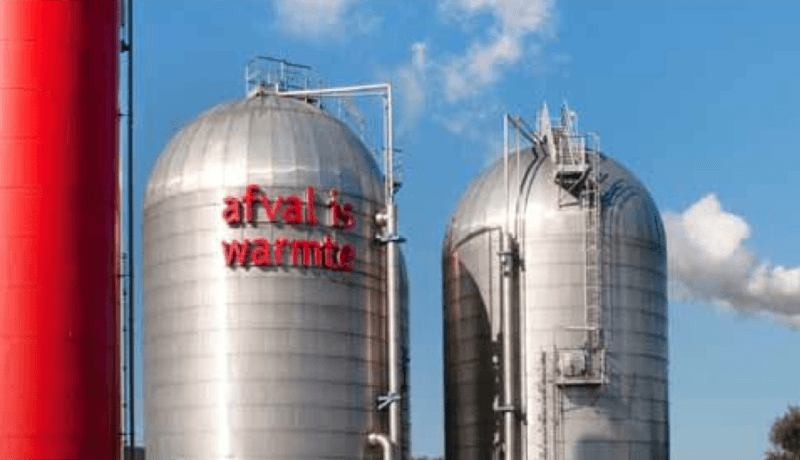Turning a party into renewable energy
April 29, 2011
on
on

As the Dutch are preparing for their annual Queens Day celebration tomorrow, the capital is gearing up to deal with record amount of trash the party produces every year. Amsterdam hosts a city-wide party expecting 200.000 visitors. The festivities are estimated to produce a 300.000 kilo’s (660.000 pounds) of waste. Luckily, Amsterdam has a long tradition of being innovative when it comes to putting litter to use, burning waste to produce electricity since 1919.
The city-owned Waste and Energy Company (Afval Energie Bedrijf AEB) is a world leader in waste-to-energy (W2E) innovation. Their Waste Fired Power Plant (WFPP) taken into operation in 2007 has an electrical efficiency of 30%. This is 8% higher than the average W2E plant. Despite the high score, the company is committed to increasing efficiency to 40% by 2020. Most of their innovations being designed in-house or in collaboration with other companies and technological institutions.
AEB converts 1.4 million tons of waste into 1 million MWh electricity annually. Amsterdam’s trams and subway systems, city hall and public street lighting are all powered by the city’s own waste. But there is more. The excess heat generated during combustion is used to provide district heating and hot water to households and businesses. In the near future another 30 to 50 thousand households will be connected to the heat network. Thus greatly reducing the need for the number of individually owned fossil fuel burning boilers.
The bottom ash that is left after the incineration process is also reused. Precious metals are recovered and whatever residue is left is put to use in the construction of roads. The result of the entire process is that 99% of the waste is recycled one way or another.
Always looking for more ways to recycle AEB has now teamed up with Waternet the first full circle water company in The Netherlands. Waternet takes care of providing clean drinking water, water purification and keeping the intricate Dutch groundwater system at level. A new Sewer Water Purification Installation was built next to AEB. Purifying the water produces sludge and bio gasses as byproducts. These are now fed to the WFPP to produce renewable electricity. In return AEB delivers free energy and heat to the purification installation.
Tomorrow when Amsterdam’s guests are all partied out and hop on a tram on their way home, they probably won’t realize that the refuse they left behind will power that vehicle for at least a month.
Source: http://www.techthefuture.com/energy/turning-a-party-into-renewable-energy/
The city-owned Waste and Energy Company (Afval Energie Bedrijf AEB) is a world leader in waste-to-energy (W2E) innovation. Their Waste Fired Power Plant (WFPP) taken into operation in 2007 has an electrical efficiency of 30%. This is 8% higher than the average W2E plant. Despite the high score, the company is committed to increasing efficiency to 40% by 2020. Most of their innovations being designed in-house or in collaboration with other companies and technological institutions.
AEB converts 1.4 million tons of waste into 1 million MWh electricity annually. Amsterdam’s trams and subway systems, city hall and public street lighting are all powered by the city’s own waste. But there is more. The excess heat generated during combustion is used to provide district heating and hot water to households and businesses. In the near future another 30 to 50 thousand households will be connected to the heat network. Thus greatly reducing the need for the number of individually owned fossil fuel burning boilers.
The bottom ash that is left after the incineration process is also reused. Precious metals are recovered and whatever residue is left is put to use in the construction of roads. The result of the entire process is that 99% of the waste is recycled one way or another.
Always looking for more ways to recycle AEB has now teamed up with Waternet the first full circle water company in The Netherlands. Waternet takes care of providing clean drinking water, water purification and keeping the intricate Dutch groundwater system at level. A new Sewer Water Purification Installation was built next to AEB. Purifying the water produces sludge and bio gasses as byproducts. These are now fed to the WFPP to produce renewable electricity. In return AEB delivers free energy and heat to the purification installation.
Tomorrow when Amsterdam’s guests are all partied out and hop on a tram on their way home, they probably won’t realize that the refuse they left behind will power that vehicle for at least a month.
Source: http://www.techthefuture.com/energy/turning-a-party-into-renewable-energy/
Read full article
Hide full article


Discussion (0 comments)